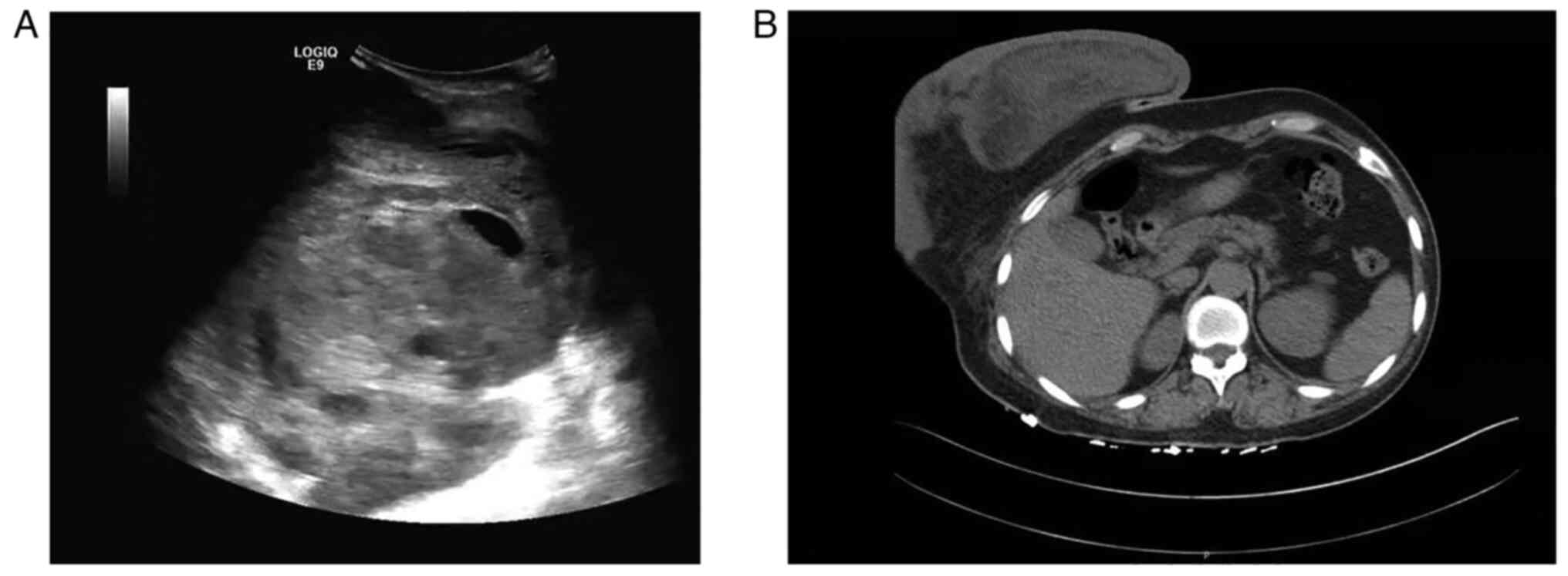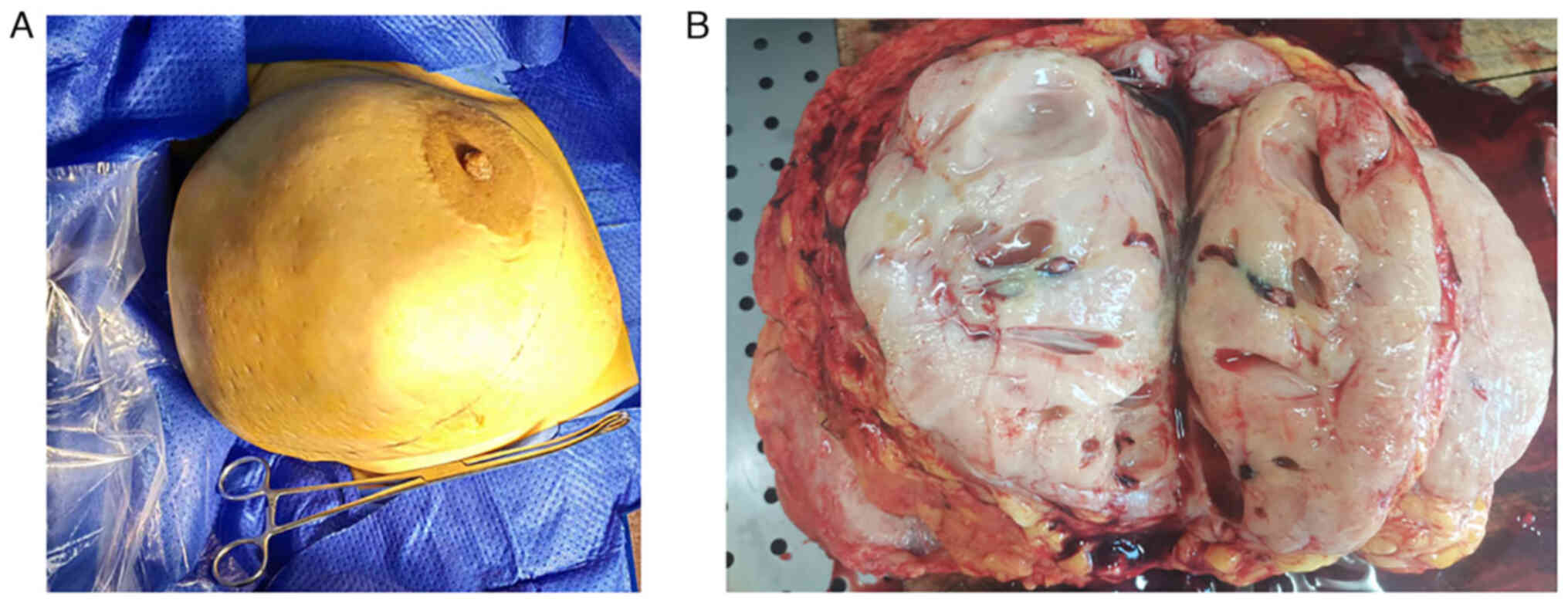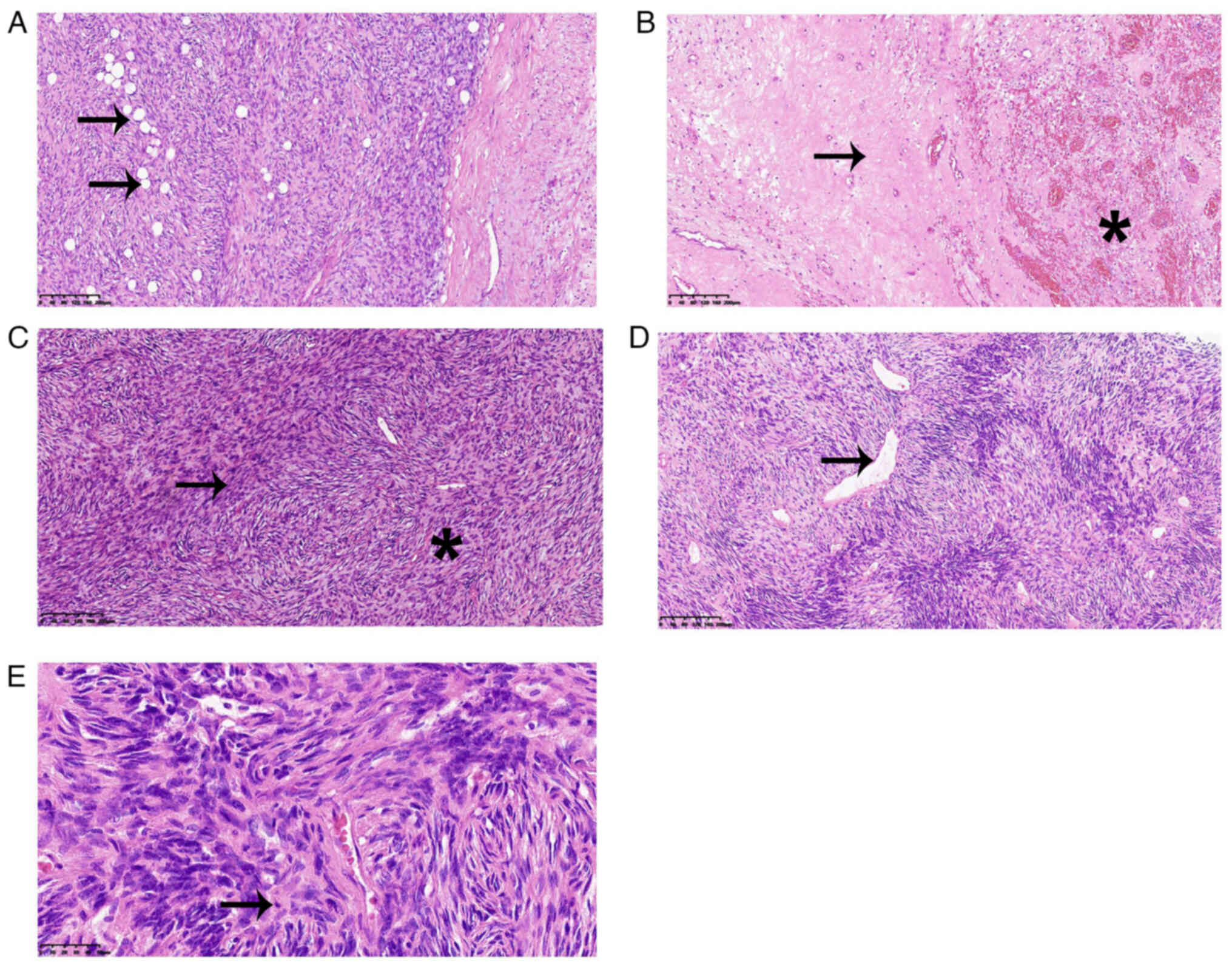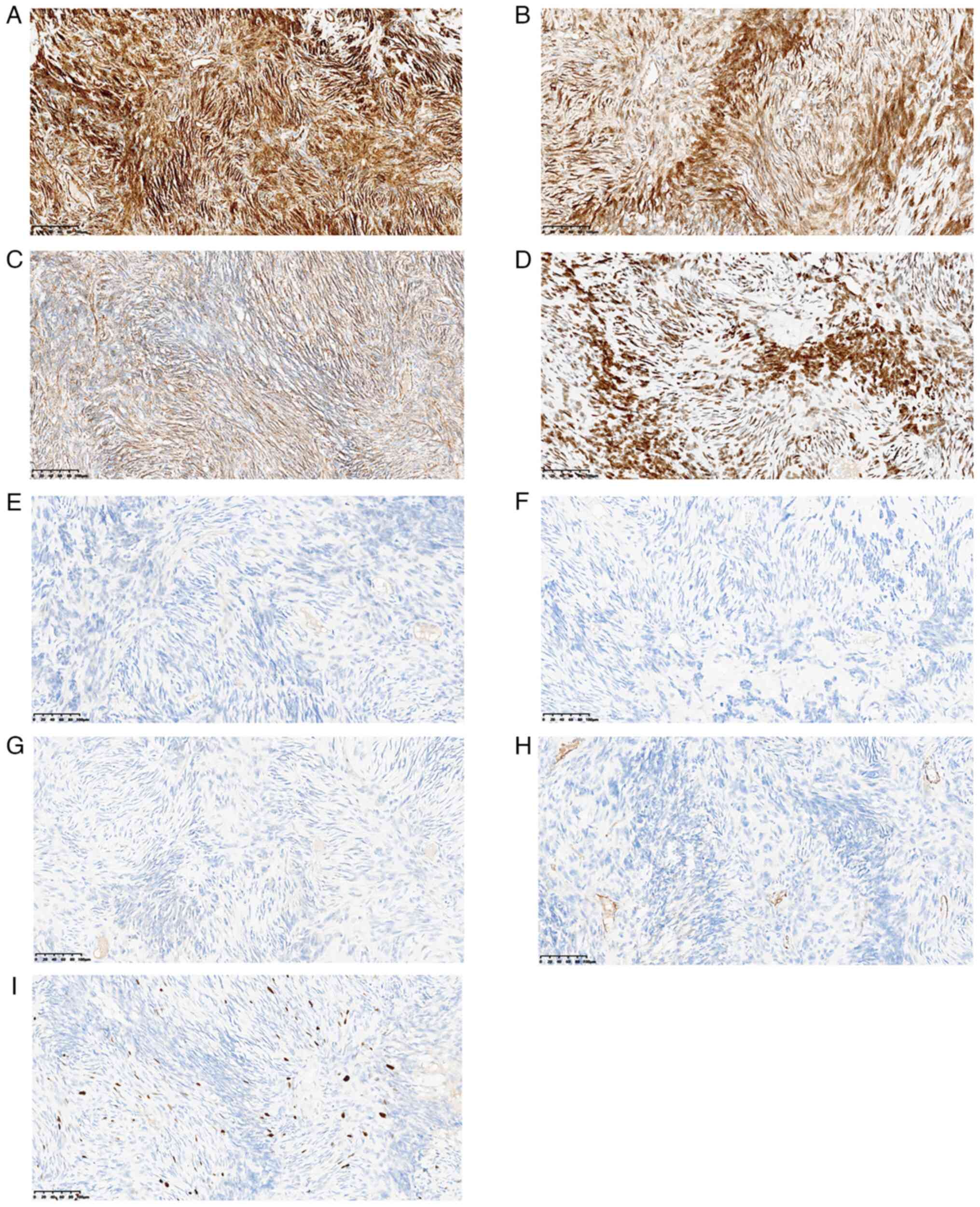|
1
|
Klemperer P and Coleman BR: Primary
neoplasms of the pleura. A report of five cases. Am J Ind Med.
22:1–31. 1992. View Article : Google Scholar : PubMed/NCBI
|
|
2
|
Kinslow CJ and Wang TJC: Incidence of
extrameningeal solitary fibrous tumors. Cancer. 126:40672020.
View Article : Google Scholar : PubMed/NCBI
|
|
3
|
Kazazian K, Demicco EG, de Perrot M,
Strauss D and Swallow CJ: Toward better understanding and
management of solitary fibrous tumor. Surg Oncol Clin N Am.
31:459–483. 2022. View Article : Google Scholar : PubMed/NCBI
|
|
4
|
Chmielecki J, Crago AM, Rosenberg M,
O'Connor R, Walker SR, Ambrogio L, Auclair D, McKenna A, Heinrich
MC, Frank DA and Meyerson M: Whole-exome sequencing identifies a
recurrent NAB2-STAT6 fusion in solitary fibrous tumors. Nat Genet.
45:131–132. 2013. View
Article : Google Scholar : PubMed/NCBI
|
|
5
|
England DM, Hochholzer L and McCarthy MJ:
Localized benign and malignant fibrous tumors of the pleura. A
clinicopathologic review of 223 cases. Am J Surg Pathol.
13:640–658. 1989. View Article : Google Scholar : PubMed/NCBI
|
|
6
|
Kawaguchi S, Kinowaki K, Tamura N,
Nishikawa A, Shibata A, Tanaka K, Kobayashi Y, Ogura T, Sato J and
Kawabata H: Solitary fibrous tumor of male breast: A case report
and literature review. Medicine (Baltimore). 101:e321992022.
View Article : Google Scholar : PubMed/NCBI
|
|
7
|
Jung MJ, Alrahwan D, Dubrovsky E, Baek D,
Ayala AG and Ro JY: Solitary fibrous tumor of breast with
anaplastic areas (Malignant Solitary Fibrous Tumor): A case report
with review of literature. J Breast Cancer. 22:326–335. 2019.
View Article : Google Scholar : PubMed/NCBI
|
|
8
|
Spak DA, Plaxco JS, Santiago L, Dryden MJ
and Dogan BE: BI-RADS® fifth edition: A summary of
changes. Diagn Interv Imaging. 98:179–190. 2017. View Article : Google Scholar : PubMed/NCBI
|
|
9
|
Dubois C, Nika E, Hoffmann P, Delouche A,
Michy T and Philippe AC: Solitary fibrous tumor of the breast: A
rare entity. Breast J. 26:289–290. 2020. View Article : Google Scholar : PubMed/NCBI
|
|
10
|
Barthelmeß S, Geddert H, Boltze C,
Moskalev EA, Bieg M, Sirbu H, Brors B, Wiemann S, Hartmann A,
Agaimy A and Haller F: Solitary fibrous tumors/hemangiopericytomas
with different variants of the NAB2-STAT6 gene fusion are
characterized by specific histomorphology and distinct
clinicopathological features. Am J Pathol. 184:1209–1218. 2014.
View Article : Google Scholar
|
|
11
|
Kallen ME and Hornick JL: The 2020 WHO
Classification: What's new in soft tissue tumor pathology? Am J
Surg Pathol. 45:e1–e23. 2021. View Article : Google Scholar : PubMed/NCBI
|
|
12
|
Mohajeri A, Tayebwa J, Collin A, Nilsson
J, Magnusson L, von Steyern FV, Brosjö O, Domanski HA, Larsson O,
Sciot R, et al: Comprehensive genetic analysis identifies a
pathognomonic NAB2/STAT6 fusion gene, nonrandom secondary genomic
imbalances, and a characteristic gene expression profile in
solitary fibrous tumor. Genes Chromosomes Cancer. 52:873–886. 2013.
View Article : Google Scholar : PubMed/NCBI
|
|
13
|
Vogels RJ, Vlenterie M, Versleijen-Jonkers
YM, Ruijter E, Bekers EM, Verdijk MA, Link MM, Bonenkamp JJ, van
der Graaf WT, Slootweg PJ, et al: Solitary fibrous
tumor-clinicopathologic, immunohistochemical and molecular analysis
of 28 cases. Diagn Pathol. 9:2242014. View Article : Google Scholar : PubMed/NCBI
|
|
14
|
Fritchie KJ, Jin L, Rubin BP, Burger PC,
Jenkins SM, Barthelmeß S, Moskalev EA, Haller F, Oliveira AM and
Giannini C: NAB2-STAT6 Gene fusion in meningeal hemangiopericytoma
and solitary fibrous tumor. J Neuropathol Exp Neurol. 75:263–271.
2016. View Article : Google Scholar : PubMed/NCBI
|
|
15
|
Schweizer L, Koelsche C, Sahm F, Piro RM,
Capper D, Reuss DE, Pusch S, Habel A, Meyer J, Göck T, et al:
Meningeal hemangiopericytoma and solitary fibrous tumors carry the
NAB2-STAT6 fusion and can be diagnosed by nuclear expression of
STAT6 protein. Acta Neuropathol. 125:651–658. 2013. View Article : Google Scholar : PubMed/NCBI
|
|
16
|
Demicco EG, Harms PW, Patel RM, Smith SC,
Ingram D, Torres K, Carskadon SL, Camelo-Piragua S, McHugh JB,
Siddiqui J, et al: Extensive survey of STAT6 expression in a large
series of mesenchymal tumors. Am J Clin Pathol. 143:672–682. 2015.
View Article : Google Scholar : PubMed/NCBI
|
|
17
|
Vivero M, Doyle LA, Fletcher CD, Mertens F
and Hornick JL: GRIA2 is a novel diagnostic marker for solitary
fibrous tumour identified through gene expression profiling.
Histopathology. 65:71–80. 2014. View Article : Google Scholar : PubMed/NCBI
|
|
18
|
Magro G, Spadola S, Motta F, Palazzo J,
Catalano F, Vecchio GM and Salvatorelli L: STAT6 expression in
spindle cell lesions of the breast: An immunohistochemical study of
48 cases. Pathol Res Pract. 214:1544–1549. 2018. View Article : Google Scholar : PubMed/NCBI
|
|
19
|
Doyle LA, Vivero M, Fletcher CD, Mertens F
and Hornick JL: Nuclear expression of STAT6 distinguishes solitary
fibrous tumor from histologic mimics. Mod Pathol. 27:390–395. 2014.
View Article : Google Scholar : PubMed/NCBI
|
|
20
|
Demicco EG, Park MS, Araujo DM, Fox PS,
Bassett RL, Pollock RE, Lazar AJ and Wang WL: Solitary fibrous
tumor: A clinicopathological study of 110 cases and proposed risk
assessment model. Mod Pathol. 25:1298–1306. 2012. View Article : Google Scholar : PubMed/NCBI
|
|
21
|
Demicco EG, Wagner MJ, Maki RG, Gupta V,
Iofin I, Lazar AJ and Wang WL: Risk assessment in solitary fibrous
tumors: Validation and refinement of a risk stratification model.
Mod Pathol. 30:1433–1442. 2017. View Article : Google Scholar : PubMed/NCBI
|
|
22
|
Demicco EG, Griffin AM, Gladdy RA, Dickson
BC, Ferguson PC, Swallow CJ, Wunder JS and Wang WL: Comparison of
published risk models for prediction of outcome in patients with
extrameningeal solitary fibrous tumour. Histopathology. 75:723–737.
2019. View Article : Google Scholar : PubMed/NCBI
|
|
23
|
Salas S, Resseguier N, Blay JY, Le Cesne
A, Italiano A, Chevreau C, Rosset P, Isambert N, Soulie P, Cupissol
D, et al: Prediction of local and metastatic recurrence in solitary
fibrous tumor: Construction of a risk calculator in a multicenter
cohort from the French Sarcoma Group (FSG) database. Ann Oncol.
28:1979–1987. 2017. View Article : Google Scholar : PubMed/NCBI
|
|
24
|
Nitta T, Kimura K, Tominaga T, Ikari A,
Takashima Y, Hirata A, Takeshita A, Ishibashi T and Iwamoto M:
Malignant solitary fibrous tumor of the breast. Breast J.
27:391–393. 2021. View Article : Google Scholar : PubMed/NCBI
|
|
25
|
Lahon B, Mercier O, Fadel E, Ghigna MR,
Petkova B, Mussot S, Fabre D, Le Chevalier T and Dartevelle P:
Solitary fibrous tumor of the pleura: Outcomes of 157 complete
resections in a single center. Ann Thorac Surg. 94:394–400. 2012.
View Article : Google Scholar : PubMed/NCBI
|
|
26
|
Haas RL, Walraven I, Lecointe-Artzner E,
van Houdt WJ, Strauss D, Schrage Y, Hayes AJ, Raut CP, Fairweather
M, Baldini EH, et al: Extrameningeal solitary fibrous
tumors-surgery alone or surgery plus perioperative radiotherapy: A
retrospective study from the global solitary fibrous tumor
initiative in collaboration with the Sarcoma Patients EuroNet.
Cancer. 126:3002–3012. 2020. View Article : Google Scholar : PubMed/NCBI
|
|
27
|
Haas RL, Walraven I, Lecointe-Artzner E,
Scholten AN, van Houdt WJ, Griffin AM, Ferguson PC, Miah AB, Zaidi
S, DeLaney TF, et al: Radiation therapy as sole management for
solitary fibrous tumors (SFT): A Retrospective study from the
global SFT initiative in collaboration with the sarcoma patients
EuroNet. Int J Radiat Oncol Biol Phys. 101:1226–1233. 2018.
View Article : Google Scholar : PubMed/NCBI
|
|
28
|
de Bernardi A, Dufresne A, Mishellany F,
Blay JY, Ray-Coquard I and Brahmi M: Novel therapeutic options for
solitary fibrous tumor: Antiangiogenic therapy and Beyond. Cancers
(Basel). 14:10642022. View Article : Google Scholar : PubMed/NCBI
|
|
29
|
Park MS, Ravi V, Conley A, Patel SR, Trent
JC, Lev DC, Lazar AJ, Wang WL, Benjamin RS and Araujo DM: The role
of chemotherapy in advanced solitary fibrous tumors: A
retrospective analysis. Clin Sarcoma Res. 3:72013. View Article : Google Scholar : PubMed/NCBI
|
|
30
|
Stacchiotti S, Libertini M, Negri T,
Palassini E, Gronchi A, Fatigoni S, Poletti P, Vincenzi B, Dei Tos
AP, Mariani L, et al: Response to chemotherapy of solitary fibrous
tumour: A retrospective study. Eur J Cancer. 49:2376–2383. 2013.
View Article : Google Scholar : PubMed/NCBI
|
|
31
|
Constantinidou A, Jones RL, Olmos D, Thway
K, Fisher C, Al-Muderis O and Judson I: Conventional
anthracycline-based chemotherapy has limited efficacy in solitary
fibrous tumour. Acta Oncol. 51:550–554. 2012. View Article : Google Scholar : PubMed/NCBI
|
|
32
|
Levard A, Derbel O, Meeus P, Ranchère D,
Ray-Coquard I, Blay JY and Cassier PA: Outcome of patients with
advanced solitary fibrous tumors: The Centre Leon Berard
experience. BMC Cancer. 13:1092013. View Article : Google Scholar : PubMed/NCBI
|
|
33
|
Stacchiotti S, Tortoreto M, Bozzi F,
Tamborini E, Morosi C, Messina A, Libertini M, Palassini E,
Cominetti D, Negri T, et al: Dacarbazine in solitary fibrous tumor:
A case series analysis and preclinical evidence vis-a-vis
temozolomide and antiangiogenics. Clin Cancer Res. 19:5192–5201.
2013. View Article : Google Scholar : PubMed/NCBI
|
|
34
|
Schoffski P, Timmermans I, Hompes D, Stas
M, Sinnaeve F, De Leyn P, Coosemans W, Van Raemdonck D, Hauben E,
Sciot R, et al: Clinical presentation, natural history, and
therapeutic approach in patients with solitary fibrous tumor: A
retrospective analysis. Sarcoma. 2020:13859782020. View Article : Google Scholar : PubMed/NCBI
|
|
35
|
Outani H, Kobayashi E, Wasa J, Saito M,
Takenaka S, Hayakawa K, Endo M, Takeuchi A, Kobayashi H, Kito M, et
al: Clinical Outcomes of Patients with Metastatic Solitary Fibrous
Tumors: A Japanese Musculoskeletal Oncology Group (JMOG)
Multiinstitutional Study. Ann Surg Oncol. 28:3893–3901. 2021.
View Article : Google Scholar : PubMed/NCBI
|
|
36
|
De Pas T, Toffalorio F, Colombo P, Trifirò
G, Pelosi G, Vigna PD, Manzotti M, Agostini M and de Braud F: Brief
report: Activity of imatinib in a patient with
platelet-derived-growth-factor receptor positive malignant solitary
fibrous tumor of the pleura. J Thorac Oncol. 3:938–941. 2008.
View Article : Google Scholar : PubMed/NCBI
|
|
37
|
George S, Merriam P, Maki RG, Van den
Abbeele AD, Yap JT, Akhurst T, Harmon DC, Bhuchar G, O'Mara MM,
D'Adamo DR, et al: Multicenter phase II trial of sunitinib in the
treatment of nongastrointestinal stromal tumor sarcomas. J Clin
Oncol. 27:3154–3160. 2009. View Article : Google Scholar : PubMed/NCBI
|
|
38
|
Valentin T, Fournier C, Penel N, Bompas E,
Chaigneau L, Isambert N and Chevreau C: Sorafenib in patients with
progressive malignant solitary fibrous tumors: A subgroup analysis
from a phase II study of the French Sarcoma Group (GSF/GETO).
Invest New Drugs. 31:1626–1627. 2013. View Article : Google Scholar : PubMed/NCBI
|
|
39
|
Stacchiotti S, Negri T, Palassini E, Conca
E, Gronchi A, Morosi C, Messina A, Pastorino U, Pierotti MA, Casali
PG and Pilotti S: Sunitinib malate and figitumumab in solitary
fibrous tumor: Patterns and molecular bases of tumor response. Mol
Cancer Ther. 9:1286–1297. 2010. View Article : Google Scholar : PubMed/NCBI
|
|
40
|
Gholami S, Cassidy MR, Kirane A, Kuk D,
Zanchelli B, Antonescu CR, Singer S and Brennan M: Size and
location are the most important risk factors for malignant behavior
in resected solitary fibrous tumors. Ann Surg Oncol. 24:3865–3871.
2017. View Article : Google Scholar : PubMed/NCBI
|
|
41
|
Kayani B, Sharma A, Sewell MD, Platinum J,
Olivier A, Briggs TWR and Eastwood DM: A review of the surgical
management of extrathoracic solitary fibrous tumors. Am J Clin
Oncol. 41:687–694. 2018. View Article : Google Scholar : PubMed/NCBI
|


















